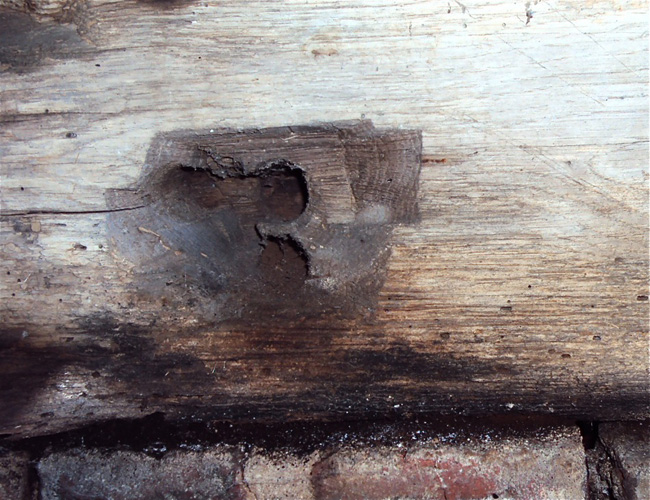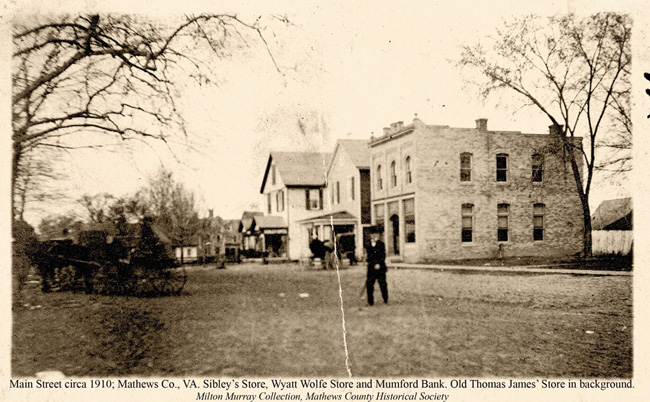Architectural Information
Site Alterations
Since the time of its construction, the Thomas James Store has undergone numerous alterations and additions, both major and minor. In spite of these various changes, the overall historical integrity of the building has remained intact. In fact, some of the alterations were completed so long ago that they have become a part of the building's history themselves.
One of the major alterations made to the Thomas James Store is its likely move from its original location, presumably facing Main Street, to its current location behind Sibley's General Store. It appears that the building was also turned when it was moved, as the current east elevation of the store was almost certainly the original front elevation, and therefore would have faced west onto Main Street. With this original orientation, the south gable door would have opened onto the side street, and could have been used as a loading door for goods.
Below is seen an unusual feature (on the outside of the current south end of the east sill, and matching an identical feature on the west sill), which was likely where the cables used to move the building were bolted. From its original location, therefore, the building would have been winched (with block and tackle) or towed (by horses, mules, or oxen), rolling on logs, and moved northward into the alley, then turned in an eastward direction and rolled until it was turned again southward and its present destination reached.This accounts for the 180-degree change in its axis.
Although there is no historical evidence to conclusively indicate that the Thomas James Store was moved from its original location, the architectural evidence for the move is compelling, as noted by both Willie Graham and Mark Wenger. The current east façade appears to be the original front elevation for several reasons; first, it is the only elevation of the original store with window openings. Stores from this time period usually limited the number of windows in the retail room to maximize wall space on which to hang shelving, with their only windows being on the front elevation, as is the case with the James Store. The widest door opening is located on the east elevation, making it a likely front door. An orientation with the current east wall originally facing Main Street would also be in keeping with the common antebellum practice of building stores with their long wall facing the street in rural areas where lot frontages were often larger and less expensive. Finally, this orientation would explain the current south-facing door; it would originally have faced the side road that is now Maple Avenue, making it useful as a loading door.[i]
In addition to the orientation of the store's elevations and openings, the lack of a chimney in the counting room could point to an early relocation. Evidence for a chimney can be seen in the sill, but not in the brick foundation where the chimney would have been. Therefore, it seems likely that the chimney was left behind when the building was moved and placed on a new foundation. This would explain the patching of the sill without any corresponding evidence in the foundation. Another detail that points to relocation is the presence of lime-wash on the underside of the ground floor joists. This is a purely aesthetic detail that only makes sense if the limewash were to be seen, pointing to the original presence of a raised cellar. Currently, the building sits over a small crawl space, which does not explain the finish. The cellar was likely left behind with the original foundation and chimney when the store was moved.
There is little evidence to disprove the relocation of the James Store other than the lack of conclusive evidence to prove that the move did occur. It is possible, though unlikely, that the store was constructed in its present location, set back from Main Street. Although we can be fairly certain that the current east elevation was the front of the building, perhaps the store was separated from Main Street by another building, as it is currently, and faced a small alley or road to the east rather than the main road. It is also possible that Maple Avenue at one time connected Main Street with Buckley Hall Road, making it a shortcut to downtown from the northeastern part of the county. If this was the case, it would have made more sense for the store to face east, because it would be facing the traffic coming southwest into downtown. It is interesting that the foundation of the (current) east front is a continuous brick wall, suggesting that this was indeed the public front, rather than the more utilitarian, spaced brick piers on the remaining three sides. Even so, there is still the lack of chimney evidence in the current foundation to explain, unless the building was simply raised and set on a new foundation after the chimney was removed.
Assuming that the Thomas James Store was relocated at some time after its construction, it is difficult to determine an approximate date for this move. The building's current foundation is fairly early, indicating that the building may have been moved when the antebellum, rear section of Sibley's General Store was constructed in the 1840s. The brick foundation is laid in English bond, which was largely out of favor by 1825, making it possible that the store was moved even before the construction of Sibley's.[ii] It also cannot be ruled out that the building was moved more than once.
Another major alteration made to the Thomas James Store is the addition of shed-roof wings on the east and west elevations of the building. These were added sometime between the second half of the nineteenth century and the early twentieth century, most likely for additional storage space. After both additions were in place, the weatherboard on the exterior of the building was replaced to create continuous siding between the central building
and the wings.
The earliest view of the James Store (seen above to the extreme right) dates between 1900, when Sibley's Store (the left building of the three large structures
behind the man crossing the street) was completed, and 1910 whenthis card was postmarked.
The store underwent a series of smaller alterations, most likely during the third quarter of the nineteenth century, which remodeled the building largely to its present interior form. The staircase from the counting room to the attic was removed, as well as the partition wall between the counting room and the retail room. The walls of the counting room, which had never been plastered, were sheathed in boards. New shelving was added in the retail room at and above counter height. Willie Graham notes that the core of the east shed addition may have been built during this remodel, shifting the main entrance of the building to the south gable door.[iii] The west shed addition was expanded by four feet c. 1950, concrete slabs poured in both shed additions. The flooring on the first floor of the original building was replaced at some time after its initial move.
Works Cited
- Atherton, Lewis A. The Southern Country Store, 1800-1860. Baton Rouge: Louisiana State University Press, 1949.
- Bradley, Stephen E., Jr. Mathews County Virginia, Censuses 1810, 1820, 1830, 1840. Self-published, 1992.
- Deed of sale from Commissioners of the Circuit Court to William N. Trader and John W. Dixon, Jr., 1893, Deed Book 10, page 403, Mathews County Clerk’s Office, Mathews, VA.
- Deed of sale from F. Joseph Sibley to Cecil Sibley, 1945, Deed Book 40, page 361, Mathews County Clerk’s Office, Mathews, VA.
- Deed of sale from Helen Miller Sibley to Cecil Sibley, 1948, Deed Book 43, page 288, Mathews County Clerk’s Office, Mathews, VA.
- Deed of sale from Jerry Fruehbrodt to Michael J. Brown, 2003, Deed Book 295, page 299, Mathews County Clerk’s Office, Mathews, VA.
- Deed of sale from John W. Dixon, Jr. to William N. Trader, 1899, Deed Book 12, page 193, Mathews County Clerk’s Office, Mathews, VA.
- Deed of sale from Mary Sibley to Jerry Fruehbrodt, 1989, Deed Book 148, page 812, Mathews County Clerk’s Office, Mathews, VA.
- Deed of sale from William Trader to Henry and F. Joseph Sibley, 1899, Deed Book 12, page 231, Mathews County Clerk’s Office, Mathews, VA.
- Federal Census of 1850, Mathews County Virginia.
- Graham, Willie. “Sibley Store: Mathews Courthouse, VA.” Unpublished report, March 3, 2006.
- Land Tax Records, 1807-1819. Mathews County Courthouse, Mathews, VA.
- Land Tax Records, 1815-1820. Mathews County Courthouse, Mathews, VA.
- Land Tax Records, 1820-1846. Mathews County Courthouse, Mathews, VA.
- Land Tax Records, 1846-1872. Mathews County Courthouse, Mathews, VA.
- Land Tax Records, 1898. Mathews County Courthouse, Mathews, VA.
- Land Tax Records, 1900. Mathews County Courthouse, Mathews, VA.
- Lounsbury, Carl L. An Illustrated Glossary of Early Southern Architecture & Landscape. New York: Oxford University Press, 1994.
- Martin, Joseph, ed. A New and Comprehensive Gazetteer of Virginia and the District of Columbia. Westminster, MD: WIllow Bend Books, 2000.
- Mason, Polly Cary. Records of Colonial Gloucester County Virginia, Volume I.
- Matheny, Emma R., and Helen K. Yates, ed. Kingston Parish Register Gloucester and Mathews Counties 1749-1827.
Mathews County Commissioner of the Revenue. Property Card, Parcel 26A3-A-107. County of Mathews, VA. http://www.emapsplus.com/vamathews/maps (accessed November 6, 2008).
- Mathews County Historical Society. History and Progress: Mathews County, Virginia. Mathews County, Virginia: Mathews County Historical Society, 1982.
- Mathews County Virginia Executors’ Bonds, 1795-1825, and Guardian Bonds, Book B, 1806-1822.
- Mathews County Visitor and Information Center. “Mathews History and Statistics.” Mathews County Visitor and Information Center. http://www.visitmathewsva.com/statistics.html (accessed October 25, 2008).
- Receipt dated May 30, 1810. Richard Billups papers. Box 4, Folder 1. Swem Library, College of William & Mary, Williamsburg, VA.
- Wenger, Mark. “Thomas James Store – Matthews (sic), Virginia.” Report, 27 November 2008.
- Will of Cecil Sibley, 1987, Will Book 17, page 537, Mathews County Clerk’s Office, Mathews, VA.

